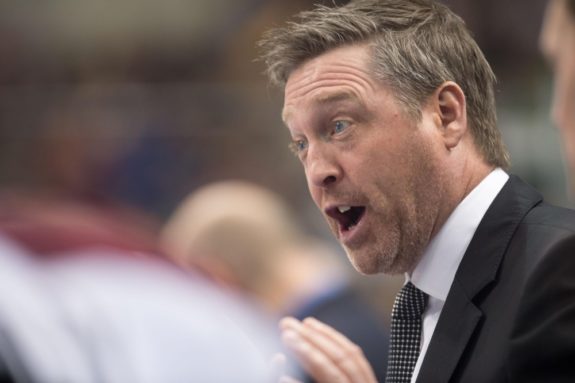Let me be clear from the very beginning, I generally like Patrick Roy as a head coach. He’s got a lot of things working for him, he does a good job working with his team and has made some very effective adjustments during his time in Colorado. That being said, the adjustments that get made, and ultimately bring the team success, seem to stick around for shorter periods of time than they should. So rather than ask whether or not Patrick Roy is a good coach, I’m curious whether or not Patrick Roy is too soft of a coach?
Coaching Type
Generally speaking, there are usually three types of coaches you see throughout the league. The motivator/disciplinarian does a lot of yelling, calls his players out frequently and comes up with some kinds of punishment in practice for bad play. John Tortorella would be an example of this. One of his most recent tactics, since joining Columbus, was to make his team do pushups when a drill didn’t go right.
https://twitter.com/NHLexpertpicks/status/664878828704169984?ref_src=twsrc%5Etfw
Then there is the tactician. This is the type of coach who seems to work systems magically; whether it is through in-game adjustments or just putting together a system that makes the team work, this guy is a master of the X’s and O’s. Mike Babcock would probably be the best example of this style of coach.
Then there is the player’s coach. He’s the type of coach that bond more with the team, finds ways to make practices more fun, won’t necessarily call players out to the media. This is Patrick Roy.
Weighing the Benefits
There are definitely some benefits to Patrick Roy being a player’s coach. The most obvious of which is that the guys he coach love playing for him. If you’ve never had the misfortune of watching a team quit on a coach because they are just tired of dealing with him, then consider yourself very lucky, because that is exactly what happened here in Colorado with Joe Sacco. Sacco was a much more of a disciplinarian, and spent most of practices, especially when things started going bad, screaming profanity at his players and forcing them to do bag skates. At some point, that wears very thin and you get what you saw from the Avalanche in those final years of what I like to call, Joe Sacco’s Reign of Terror. You don’t see this with Patrick Roy; he is always engaging with players on the ice and talking with them about things that need to improve or what he wants to see. What’s more, Roy will even spend time with his players addressing the why’s and why nots of things.
Roy also does his best to keep the negative attention away from players in the media when things get tough, while making sure they receive all the credit in the media when things are going well. Roy’s willingness to deflect criticism from his players while ensuring that the praise is delivered to them breeds a certain kind of loyalty in his players, the type where they would skate through a brick wall for you if asked.
The Downside

The downside is that perhaps Patrick Roy is too much of a player’s coach. Again, I like a lot of the things that Patrick Roy is done and continues to do as head coach of the Avalanche, but it seems that one of his biggest weaknesses is being too relaxed at times. I can already hear the other side of this: “Relaxed? The guy shouting at the officials from the bench and nearly crushing coaches with the glass between the benches is relaxed?” I hear you, this isn’t what I’m talking about.
One of the biggest issues that we have seen with the Avalanche, especially during this season, is the team’s ability to stay with adjustments when they are made. The Avalanche have had several times this season where they will have a stretch of very successful games where they play excellent, even dominant hockey. Then, for reasons completely unknown, the team will simply get away from everything they have been doing that was successful and Roy will be forced to go back and restart the whole process. Part of this is absolutely on the players, there can be no doubt about it, but part of this also speaks to Patrick Roy perhaps being too soft when the team is successful.
This is not to suggest that practices stop being difficult or challenging, but rather that Roy stops harping on the particular aspects that led to success. Obviously, if there are other issues with the team then those should be addressed, as well, but continuing to reinforce the importance of certain skills on the ice carries the same importance of a teacher in a classroom needing to reinforce expectations of his/her students. The best teachers are always finding ways to reinforce the things they want to see such as format for an essay, and a coach needs to be doing the same thing.
Again, this isn’t necessarily suggesting that Patrick Roy isn’t attempting to reinforce these things; rather, this might be suggesting that the current way in which he is doing it doesn’t quite carry enough weight with the players. Perhaps he needs to find a bit more of the disciplinarian in him to make certain that the connections that get made when addressing a problem the first time last so that he doesn’t end up having to go back and fix it again.